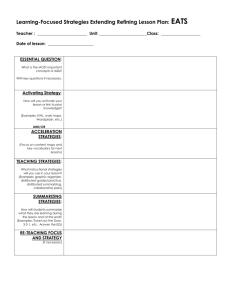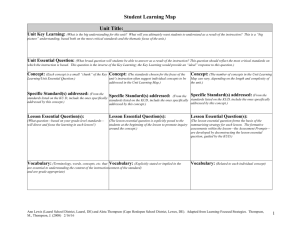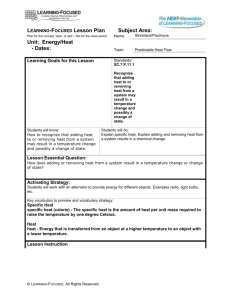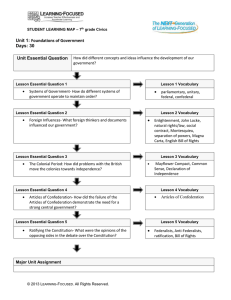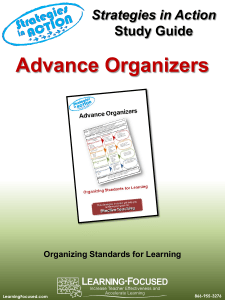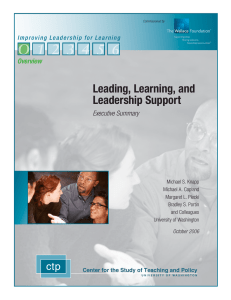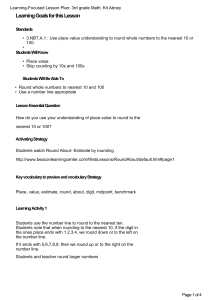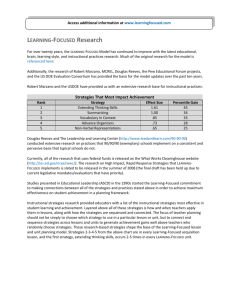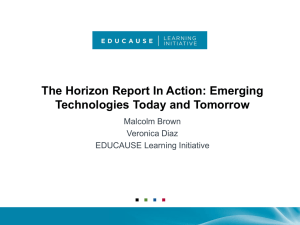Learning-Focused Introduction
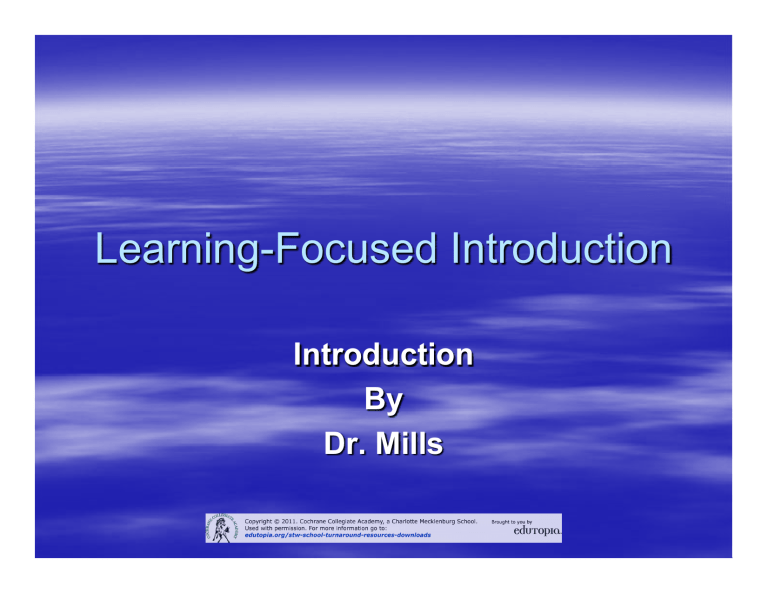
Learning-Focused Introduction
Introduction
By
Dr. Mills
What is the Learning-Focused
Strategies Model?
A framework for thinking about planning, and delivering instruction using
EXEMPLARY practices with a focus on learning.
Exemplary Practice
An Exemplary School is defined as:
A school with 90% or more of its students on or above grade level…Approximately 4300 schools out of 92,000
Exemplary Practice is defined as:
Practices and activities that exist on a
Consistent and Pervasive basis in exemplary schools
Learning-Focused helps teachers make decisions about:
Deciding what to teach
Using what you already know to teach your best
Connecting and using the most important practices/strategies in every lesson
Helping your administration observe and understand your professional teaching practices
Finding instructional time for higher level thinking activities/lessons
Learning-Focused helps teachers make decisions about:
Quickly assessing student learning
Differentiating instruction easily
Quickly building background knowledge and moving students from where they are
Accelerating learning
Integrating writing, reading comprehension, and higher level thinking
Focusing on key vocabulary and good vocabulary strategies
LEARNING-FOCUSED
Being consistent and pervasive is what makes Learning-
Focused a useful tool for students and teachers.
Consistent - it is not using a practice once a month. If a practice works when students are introduced to new material, the teacher uses it EVERY time an acquisition lesson for new information is taught.
Pervasive - “You will not move a school-raise achievement for a school-on the backs of a few stars. It takes all the teachers in the school; it takes collaboration.” Exemplary practices are pervasive-throughout the school.”
What is Learning-Focused About?
CONTINUOUS IMPROVEMENT!
With Learning-Focused you are not expected to do everything at once, but get started-try a few things, get them working well and add more. YOU DON’T Arrive-
There is ALWAYS new knowledge about what works. It’s all about CONTINUOUS
IMPROVEMENT!
Learning-Focused
Learning-Focused makes sure you have the right instructional tools, and it helps you organize those tools!
Exemplary Practices
One of the biggest differences in an exemplary school and a typical school is how and when teachers plan.
Connections
Organizing Planning
Assessment
Instruction
Curriculum
Learning-Focused
Throughout the use of Learning-Focused, standards (North Carolina Standard Course of Study/NCSCOS/Common Core
Standards) will be transformed into learning.
Learning-Focused
Teachers collaborate to do the following:
Clarify/interpret the expectation of standards in terms of knowledge, understanding and skills.
Develop student learning maps that provide a focus for teacher planning and clearly communicate the expected learning to students.
Develop common assessments that will provide evidence of student learning.
Develop lessons and units based on the learning maps from the standards.
Learning-Focused
You must connect and used all components.
This is what makes the difference between a typical school and an exemplary school!
Learning-Focused
Marzano did a meta-analysis of all the research on instructional strategies. The US
Department of Education combined
Marzano’s research with others and identified 33 strategies that impact achievement.
Top Five Strategies That Impact
Student Achievement
Rank Strategy Percentile Gain
1
2
Extended
Thinking
Summarizing
45
34
3
4
5
Vocabulary In
Context
Advance
Organizers
Non-Verbal
Representations
33
28
25
Instructional Practices Critical to
Raising Achievement
Previewing for “extra help” students
School wide lesson/unit plans
Reading k-12 across the curriculum
Writing k-12 across the curriculum
Differentiated Assignments
THESE ARE THE PRACTICES THAT
HAVE CLOSED THE ACHIEVEMENT
GAPS!
How has Learning-Focused helped achievement at Cochrane?
In the last two years, the number of students scoring proficient on the End of Grade test has increased by 22%.
This past year Cochrane not only met growth expectations but made High
Growth expectations!
How has Learning-Focused helped achievement at Cochrane?
In math nearly 61% of students did better than expected and in reading 59% of students did better than expected.
This growth is something the Cochrane
Middle School has not seen in the last 10 years.
How Do I Begin?
KUD Organizer
KUD stands for Know, Understand and Do
KUD organizers provided clarity to what students must learn.
KUD organizers makes sure that learning expectations are consistent from classroom to classroom
KUD organizers help to make sure instructional activities lead to students’ desired learning.
KUD Organizer
Know
Facts
Formulas
Vocabulary
Understand
Important ideas we want students to gain during the unit
Do
Skills
Writing
Thinking
Strategies
What’s Next?
After completing your KUD organizer, develop your Common Assessment.
Common Assessments provide a picture of how students will provide you with evidence they have learned the information that was taught.
Types of Common Assessments
Formative Assessments: used to inform instruction
Summative: used to document what students have learned.
Common Assessments
For each learning goal defined on the KUD organizer, generate ideas for how that objective can be assessed.
What’s Next?
After developing your Common
Assessments, develop a Student Learning
Map to post in your classroom each day for each unit you teach.
Student Learning Map
A Student Learning Map is a way for you to organize the concepts, skills and ideas from the KUD Organizer.
It is a graphic organizer that visually shows the key concepts and skills to be learned in the unit.
Components of a Student Learning Map
Key Learning : What the unit is about
Unit Essential Question : Question that is to be answered at the end of the unit
Concepts : Topics/Skills that will be covered. You may have more than one topic/skill that is covered in a single unit.
Lesson Essential Question : What is it that students need to be able to answer at the end of the lesson? This must also support the unit essential question
Vocabulary : What terminology will be taught during each lesson?
How Do You Plan an Acquisition
Lesson?
Write the lesson essential question. Develop the assessment prompts by asking: What must students learn in order to answer the lesson essential question?
Choose and complete the graphic organizer for the lesson.
Use the first two steps to organize the teaching component of the lesson:
Learning Experience (Instruction)
*Assessment Prompt
Learning Experience (Instruction)
*Assessment Prompt
Learning Experience (Instruction)
*Assessment Prompt
How Do You Plan an Acquisition
Lesson
Plan the Assignment
Plan the Activating Strategy
Plan the Summarizing Strategy
Top 10 Interactive Learning-
Focused Non-Negotiables!!
Essential Questions - what is the goal of the lesson? What do you expect your students to know by the conclusion of the lesson?
Activating Strategy - Something that gets students actively thinking or making a connection to the content or the outside world
Top 10 Interactive Learning-
Focused Non-Negotiables!!!
Relevant Vocabulary - Keep vocabulary limited to what your students will be able to handle and make sure that it is actively used in context throughout the lesson.
Limited Lecture - After 12-15 minutes of lecture, students should be engaged in some type of activity, even it it’s only for a few minutes.
Top 10 Interactive Learning-
Focused Non-Negotialbes
Graphic Organizer - Allows students to visually categorize new information or review old information. Have students present information in colorful charts in their notebooks or create foldables to move away from pages of note-taking.
Top 10 Interactive Learning-
Focused Non-Negotiables
Student Movement - This is a must!
Students need to be mobile at some point in time during instruction to ensure active engagement (i.e. collaborative pairs, rotations stations, gallery walk, etc.).
Top 10 Interactive Learning-
Focused Non-Negotiables
Higher Order Thinking Questions :
Present your students with 3 higher order thinking questions during the lesson. This is proof that you are presenting your students with challenging work and meeting the needs of your advanced learners!
Top 10 Interactive Learning-
Focused Non-Negotiables
Summarize - This is a way to bring the lesson to a close. This is where you are able to assess your students’ ability to effectively answer the essential question and find out whether you need to extend or refine the skill.
Top 10 Interactive Learning-
Focused Non-Negotiables
Rigorous - The activities must be challenging and move at a brisk pace. There should be no opportunities during the block where students get bored or have nothing to do because the entire lesson is an Active
Lesson!
Top 10 Interactive Learning-
Focused Non-Negotiables
Student Centered - Remember, you do all the planning and your students do all of the working! If you effectively and successfully plan, your students will effectively and successfully work and learn!
Remember…
Learning-Focused is all about using
BEST PRACTICES!
